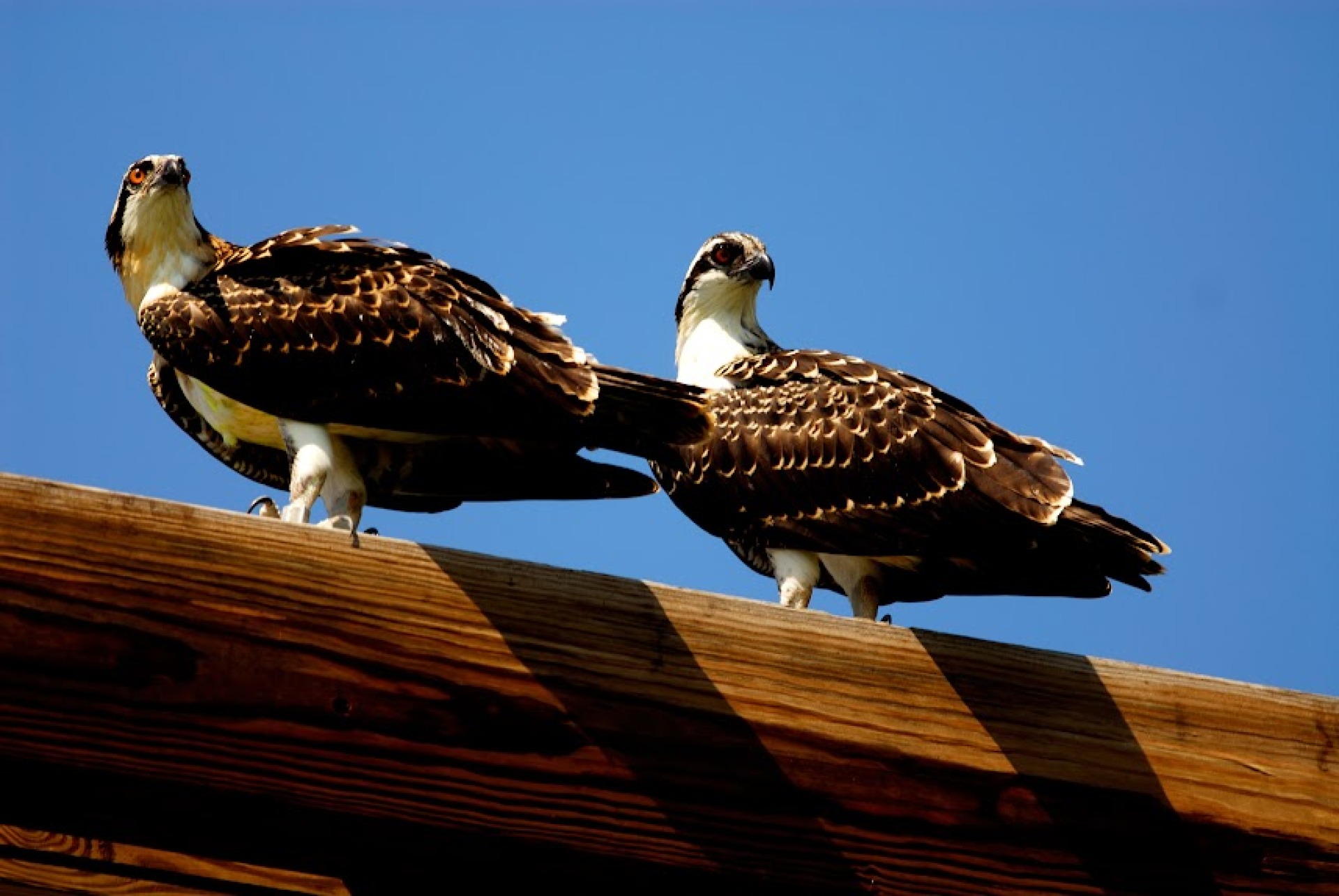Wildlife Restoration
Marla Mertz, Marion County Conservation, and Linette Bernard, Feathers & Ink
If you read journals from pioneer settlers in Iowa… they talk about a much different landscape and many different animal residents! Some of the animals that were here when Iowa achieved statehood are now extinct (i.e. passenger pigeon) while others were extirpated (no longer found here, but are found elsewhere) from these parts by the early 1900s. Wildlife restoration must start with habitat improvement and restoration.
The Iowa Department of Natural Resources spearheads many of the wildlife restoration efforts with assistance from county conservation boards, college and university student clubs, “fin and feather” groups, and nonprofits.
Why would these groups go to the work and expense to restore wildlife populations? You could answer that question with it’s our natural heritage! In the broad sense, it is about trying to restore some semblance of the natural ecosystem by replacing some of the missing pieces. Restoring these pieces highlights the need for conservation and improvement of habitats.
Many of the wildlife species chosen for reintroduction efforts are examples of 'umbrella species' – those that have such wide habitat needs that when habitat improvements are made for these umbrella species you end up impacting for the good many wildlife species. The prairie chicken is a great example of an umbrella species. Prairie chickens have such wide habitat needs and require such a large landscape of grassland that by managing for prairie chickens, you end up managing for many grassland species, especially other grassland birds.
Let’s look at a few wildlife restoration projects in Iowa: 7 Iowa Wildlife Comebacks Iowa DNR
Wild turkey - The first settlers to cross the Mississippi River into what would become Iowa found wild turkeys in abundance. Settler’s journals tell us that turkeys were found where there was oak-hickory forest (one of the wild turkey’s favorite foods are acorns) and that turkey was a staple in their diet. Turkey populations depleted as did our forests.
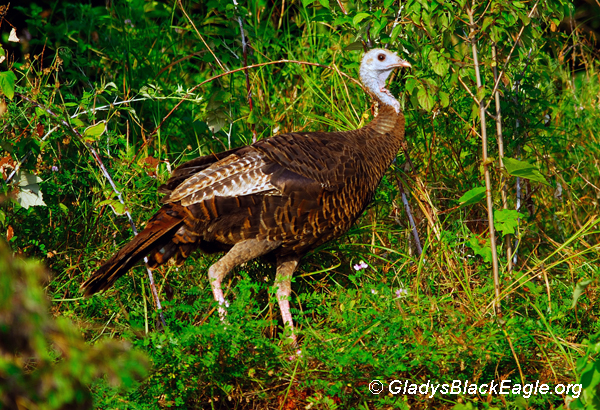
The Eastern wild turkey was extirpated from northeast Iowa by 1854 and very low numbers remained in southern Iowa by 1900. Initial restocking efforts were attempted with pen-raised turkeys in the 1920s and 30s. These releases were assumed to have failed. In the early 1960s other subspecies of wild turkey were released in Allamakee, Lucas, and Monroe Counties with limited success.
In 1966, 11 Eastern wild turkeys were released at Shimek State Forest. These birds were wild-raised and caught in Missouri. The population of these birds took off! By the winter of 1971-72, wild turkey numbers in the state were large and stable enough to trap and relocate to other suitable habitats within the state.
The Eastern subspecies has adapted well to habitat conditions in Iowa and by 1980, the Iowa DNR was able to trap wild turkeys and use them to trade for other Iowa-extirpated wildlife like prairie chickens, ruffed and sharp-tailed grouse, and river otters.
Learn more about wild turkeys from the Iowa DNR (PDF)!
What can I do to help?
If you have timber on your property, look to these agencies for help with care and management
Prairie chicken - The Iowa DNR developed a management plan for the greater prairie chicken. The 2012 plan includes a detailed analysis of habitat in Ringgold County, Iowa and recommendations for managing that habitat for prairie chickens.
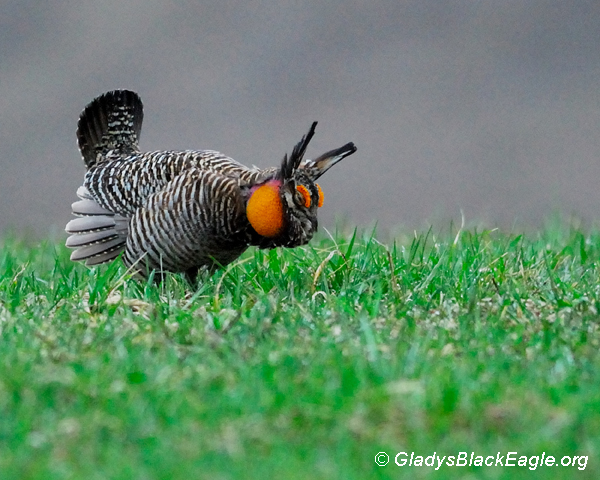
In the short-term, the plan suggests trapping and releasing roughly 350 birds between 2012 and 2015. In early April 2012, 50 birds (25 male and 25 females) were trapped in southwest Nebraska and released within 24-hours on the two active lek (booming grounds where males do their best calling and dancing to attract a female) sites within the Kellerton Grasslands Bird Conservation Area in southern Ringgold County, IA.
A portion of the plan also proposes a translocation effort to help bolster the diminishing population of birds.
-
- More info from the Iowa DNR prairie chicken page
- Learn about prairie chicken courtship and habitat needs in the March / April 2009 article, "Boom Time!" from the Iowa DNR publication, Iowa Outdoors (opens as PDF)
- Booming from the Mists of Nowhere - Iowa Public Radio 2/22/2016
What can I do to help?
- Contact your local Farm Service Agency office to talk about enrollment options in conservation programs. Click here for link to State FSA pages.
Osprey reintroduction efforts - Ospreys have always passed through Iowa on their migration trek, but no nesting had been documented since European settlement. Iowa has been involved in a restoration project with Minnesota and Wisconsin since 1997. The planning for these birds to be relocated in Iowa takes months, working off and on over the course of a year. The availability of young osprey for relocation is evaluated in early July. Minnesota and Wisconsin officials locate nests where more than one young exists that are approximately 42 days old. Then Iowa officials and volunteers make the trek to receive the young birds to bring back to Iowa.
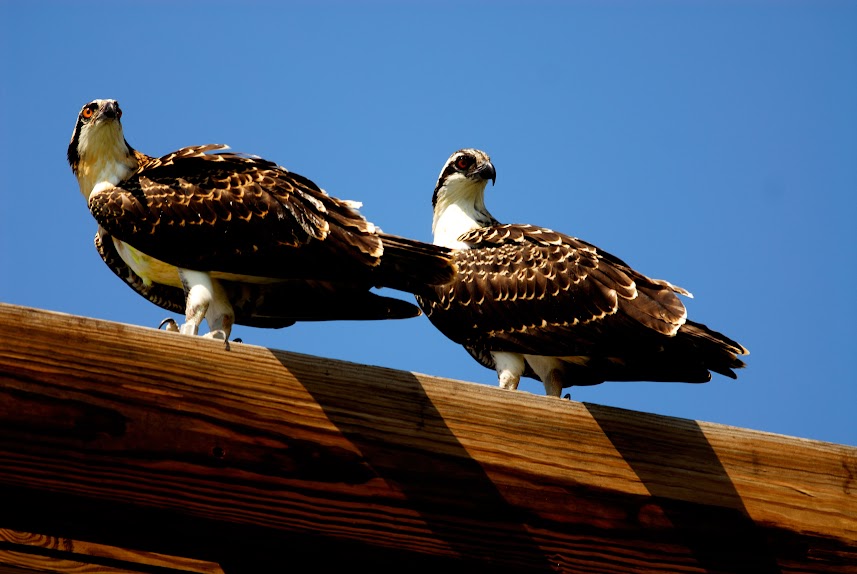
When the young osprey reach Iowa, they are checked out by a veterinarian and raptor rehabilitator and are placed at the chosen hack sites. Hacking is an ancient falconry technique of slowly releasing young birds back to the wild from a secure tower structure. They are provided with food and water as they learn how to fly and become proficient hunters. Hack sites are usually chosen in an area where the osprey will compliment the diversity within the river corridors.
When the birds are placed in the hack tower in July, there is much to do on their "growing up" agenda. They must be healthy, learn to fish, out-maneuver predators, learn their hunting territories and prepare for the long trek of migration to South and Central America by the first week of September.
The years 2005-2008 were contracted years between Marion County and the State of Iowa for osprey release and the opportunities continued on through 2011 in conjunction with other areas releasing. The Marion County osprey hack tower was constructed at Elk Rock State Park by Newton Correctional Facility Inmates, IDNR and Marion County Conservation employees, and volunteers. The tower was dedicated in memory of Gladys Black in 2006 as the Gladys Black Raptor Learning Site.
From 1997 through 2015, 301 Ospreys have been released at twelve sites. Since 2003, 200 wild ospreys have been produced at 113 successful nests.
- 2014 Iowa osprey nest map (from the Iowa DNR, opens as PDF)
- 2015 Iowa osprey nest map (from the Iowa DNR, opens as PDF)
Learn more about osprey here:
Check out this Google Photos album to see pics of osprey reintroduction efforts in Iowa. Reintroduction efforts have been successful.
What can I do to help?
- Whenever visiting parks, natural areas, rivers, ponds, reservoirs... pack it in and pack it out. Remember to leave the area cleaner than you found it and to take only photos and memories.
- Be sure to clean up fishing line and tackle snagged in trees and rocks. Fish hooks and line are a serious hazard to water-loving birds.
- Consider using non-toxic fishing tackle.
Peregrine falcon - Prior to 1960, there were over 350 nests in the eastern U.S. By 1964 not a single peregrine nest was found in the eastern U.S. and in 1975, only 39 peregrine pairs remained in the lower 48 states.
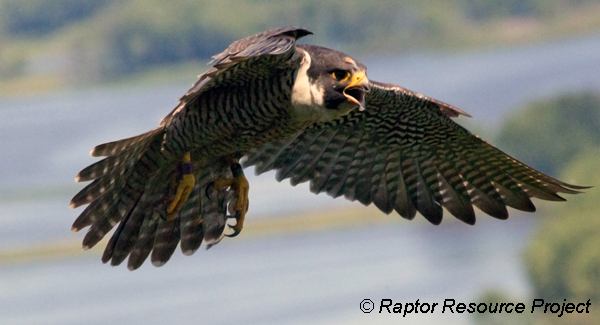
The dramatic decline of these birds was due to the effects from the pesticide DDT. The pesticides were ingested by birds that ate insects, which, in turn, were eaten by peregrines. With each step up the food chain negative effects increased. The dangers of DDT were eventually recognized and the pesticide was banned from use in the U.S. in 1972. The peregrine had already been proven as a valuable indicator of the quality of our environment.
To restore peregrines, biologists with the Peregrine Fund began hacking young falcons in 1974 in eastern states. In the Midwest, peregrines were first hacked in southeastern
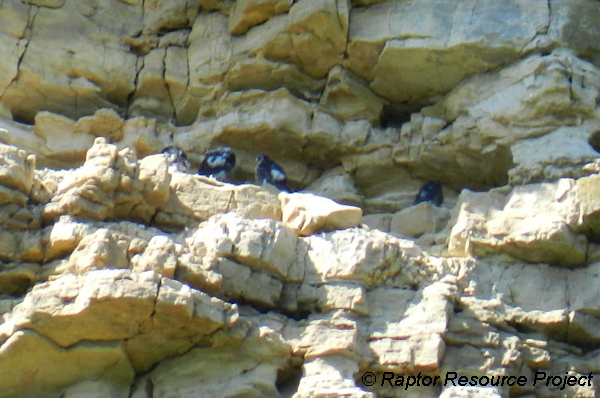
Minnesota in 1982. From 1989-1992, Iowa hacked 50 peregrines in Cedar Rapids, Des Moines, and Muscatine, as part of the Midwestern effort. In 1986, the Midwest had its first peregrine falcon nest in nearly 30 years. By the year 2000, there were 129 peregrine falcon pairs that successfully fledged 243 young. The recovery goal of 40 nesting pairs for the Midwest had been surpassed.
The peregrine falcon was removed from the federal threatened and endangered species list on August 25, 1999. The Iowa Natural Resource Commission lists the peregrine falcon as an Iowa species of special concern.
-
- Raptor Resource Project
- Peregrine Falcons
- Learn more about Iowa DNR peregrine recovery efforts
What can I do to help?
- Remember that falcons are a protected species under The Migratory Bird Treaty Act of 1918. This law protects migratory birds and any part, nest, or egg of any such bird, except as allowed for by specific law (like duck and goose hunting).
River otter - The river otter was very common in Iowa prior to settlement. Otters were extirpated from most of Iowa by unregulated trapping, polluted streams, and removal of habitat.
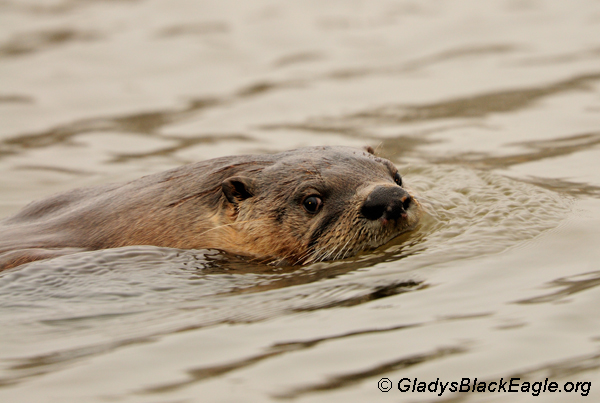
Otter reintroduction efforts began in the 1970s in North America. Sixteen otters from Louisiana were released in 1985 at Lake Red Rock, as a pilot project to determine the suitability of Iowa’s water resource for otters. The Red Rock otters survived very well and established normal habitat use patterns. 345 otter were released in Iowa between 1985 and 2003. Otter reintroduction would not have been successful without wetland restoration and conservation efforts in Iowa.
What can I do to help?
- Whenever visiting parks, natural areas, rivers, ponds, reservoirs... pack it in and pack it out. Remember to leave the area cleaner than you found it and to take only photos and memories.
- Be sure to clean up fishing line and tackle snagged in trees and rocks. Fish hooks and line are a serious hazard to water-loving animals.
- Consider using non-toxic fishing tackle.
Trumpeting the Cause for Iowa Wetlands - The magnificent trumpeter swans are North America’s largest waterfowl and weighing from 25-32 pounds. They nested throughout Iowa prior to settlement, but the draining of wetlands and unregulated hunting brought their demise in the early 1880s. By the early 1930s, just 69 trumpeters remained in the continental United States. The Iowa Department of Natural Resources began a restoration program in 1993, with the first wild nest occurring in 1998. The State of Iowa reached a major milestone in 1998, 1999, and again in 2000, when the first and second free-flying trumpeters nested in Iowa since 1883. In 2010, 42 wild pairs of trumpeter swans were found nesting in Iowa. The continued success of trumpeter restoration efforts are not complete, but rely on the commitment of volunteers and concerned citizens that value the swans and their habitat. Although, the Iowa DNR is phasing out the swan restoration program, local conservation boards, naturalists and committed volunteers will continue to oversee the efforts as best as they can. The Iowa State University Trumpeter Swan Restoration Committee is continuing restoration efforts.

One thousand trumpeter swans have been released in Iowa and have been reported in 16 states including Colorado, Texas, Virginia and 2 provinces of Canada.
What can I do to help?
- Whenever visiting parks, natural areas, rivers, ponds, reservoirs... pack it in and pack it out. Remember to leave the area cleaner than you found it and to take only photos and memories.
- Be sure to clean up fishing line and tackle snagged in trees and rocks. Fish hooks and line are a serious hazard to water-loving birds.
- Consider using non-toxic fishing tackle.
Barn owl - The barn owl is now very rare in the northern part of their range (including Iowa) due to severe winter weather, the conversion of grasslands and pastures to row crops, the loss of large cavity nest trees and wooden farm buildings, and predation from cats and great horned owls. The common barn owl has been listed on the Iowa Endangered Species list since 1977. These owls remain on the Iowa endangered species despite extensive efforts to provide nesting structures in prime habitat areas, particularly in the southern portion of the state.
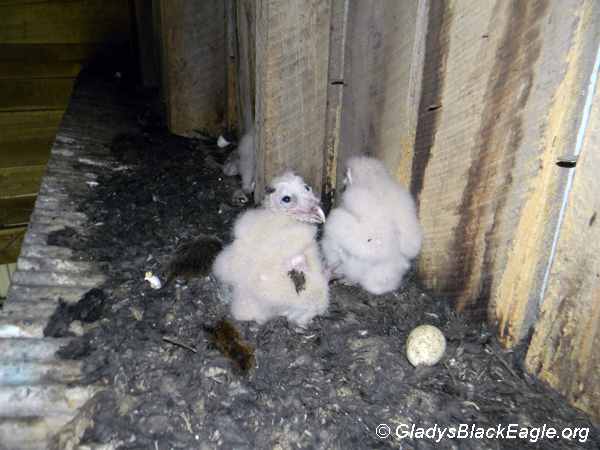
-
- Barn owl brochure from the Iowa DNR (opens as PDF)
What can I do to help?
If you live in areas where there have been documented sightings of barn owls and you live near open grasslands AND you have outbuildings, consider building a nesting structure to invite barn owls and other raptors to help control your rodent population naturally. It's more cost effective to invite natural predators of rodents and safer for your family and the environment than using rodenticides.
Prairie Habitat Restoration
These restoration projects are one example of management techniques required to increase the populations and ranges of species towards their pre-settlement levels. We can assume that if wildlife habitats had not been drastically reduced and altered or species would not have been over-harvested, the above restorations and other aggressive management measures would not be required today. In order to better understand the importance of habitats that directly affect Iowa’s wildlife, we must first examine the habitats’ origins.
After the retreat of the last glacial event in Iowa, the landscape gradually changed with the climate. During this time, plant communities evolved to produce a diversity of wildlife and supporting habitats. As prairies and forests battled for supremacy, drier conditions and frequent fires allowed prairie ecosystems to eventually cover approximately 85% of Iowa. Grasslands were dominant, but large tracts of forests were found along streams and river corridors and prairie wetlands followed the retreat of the last glacier in north-central Iowa. Smaller areas, called savannas, were composed of a mixture of grasslands and scattered fire-tolerant trees such as burr oaks.
Prairie species soon adapted to and survived drought and frequent fires. By developing deep root systems, energy reserves, and dormant buds that lie below the soil surface, these perennials could die back every fall or be periodically burned. They had the ability to survive one year to the next. The dense roots and vegetation also helped keep out invading woody species. As the prairie thrived under such conditions, woody species and non-herbaceous plants could not adapt. Grazing or browsing animals such as bison, elk, and antelope, helped recycle nitrogen, helped suppress woody species, and opened up habitat for plant species that prefer some soil disturbance by trampling. These disturbances created a patchy environment that supported a wide variety of plants and animals and helped maintain prairie ecosystems.
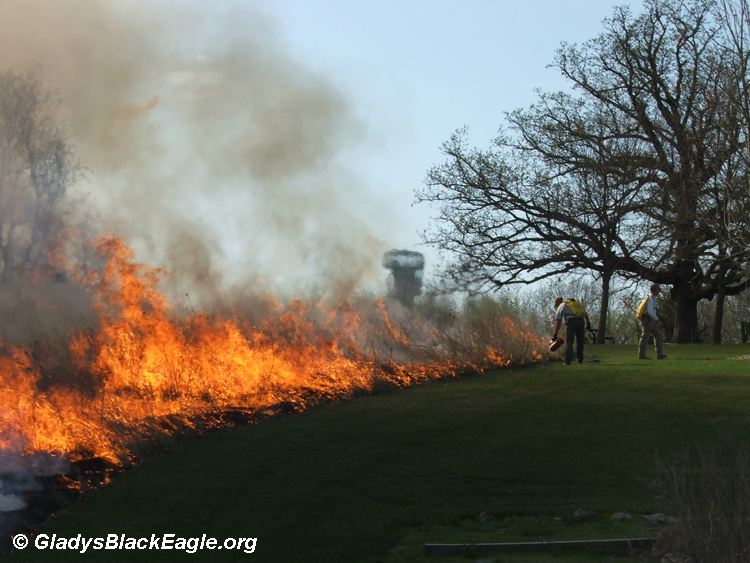
Management of Iowa’s natural resources is not modern science. Techniques began prior to federal, state, and county conservation agencies taking on these responsibilities – some 300 years ago by Native Americans - the first resource managers. Pre-settlement prairie fires not caused by lightning were started by Native Americans who saw the value of fires in managing grasslands and the larger herbivores like bison and elk. Although these fires probably burned every three to 10 years and were sporadic, they had the same positive affect that managers strive for today.
Iowa’s prairies developed over thousands of years, yet it took less than a century after settlement for nearly all of our prairies to vanish. Early pioneer farmers realized the ground under prairies was some of the most fertile and would be suitable for agriculture. Thirty million acres of prairies were converted to farm land in less than 80 years.
Concerned Iowans eventually realized the loss and soon placed a high value on the remaining prairie remnants found in the state. Management biologists inventoried these native remnants and concluded that due to the suppression of fires and the loss of grazing by elk and bison, the quality of grasslands was severely diminishing. Today, management techniques center on the natural role of fire and the simulated grazing of bison (mowing or haying) the same things that were in effect from the beginning and through the evolution of prairie communities.
What happens when prairie areas are left unmanaged?
- Wildlife is not allowed enough space to move around, find cover, and locate food in dense prairies.
- An accumulation of thick mats of plant litter slows plant growth.
- An invasion of shrubs and trees – succession.
- The encroachment of alien weeds and grasses.
Learn more about prairie habitat management!
published Monday, April 1, 2019

